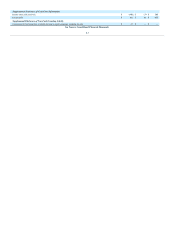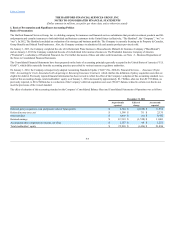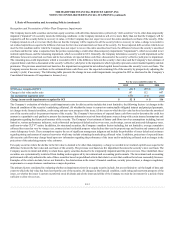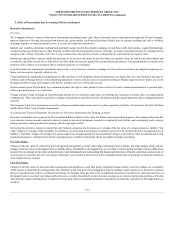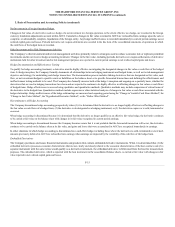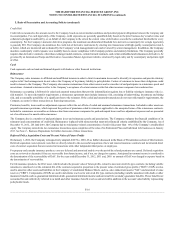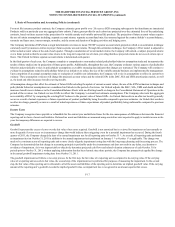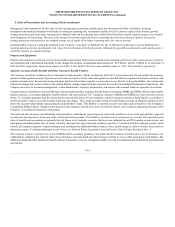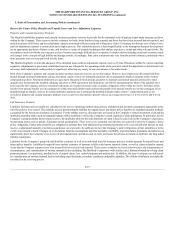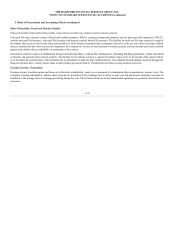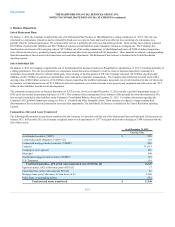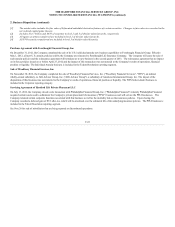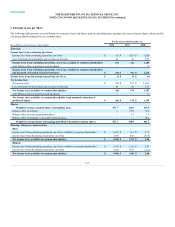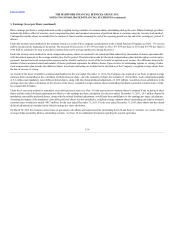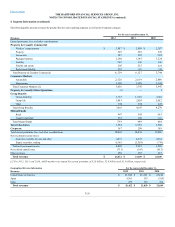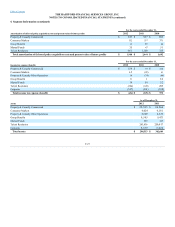The Hartford 2012 Annual Report Download - page 158
Download and view the complete annual report
Please find page 158 of the 2012 The Hartford annual report below. You can navigate through the pages in the report by either clicking on the pages listed below, or by using the keyword search tool below to find specific information within the annual report.
For most life insurance product contracts, the Company estimates gross profits over 20 years as EGPs emerging subsequent to that timeframe are immaterial.
Products sold in a particular year are aggregated into cohorts. Future gross profits for each cohort are projected over the estimated lives of the underlying
contracts, based on future account value projections for variable annuity and variable universal life products. The projection of future account values requires
the use of certain assumptions including: separate account returns; separate account fund mix; fees assessed against the contract holder’s account balance;
surrender and lapse rates; interest margin; mortality; and the extent and duration of hedging activities and hedging costs.
The Company determines EGPs from a single deterministic reversion to mean (“RTM”) separate account return projection which is an estimation technique
commonly used by insurance entities to project future separate account returns. Through this estimation technique, the Company’s DAC model is adjusted to
reflect actual account values at the end of each quarter. Through consideration of recent market returns, the Company will unlock, or adjust, projected returns
over a future period so that the account value returns to the long-term expected rate of return, providing that those projected returns do not exceed certain caps or
floors. This Unlock for future separate account returns is determined each quarter.
In the third quarter of each year, the Company completes a comprehensive non-market related policyholder behavior assumption study and incorporates the
results of those studies into its projection of future gross profits. Additionally, throughout the year, the Company evaluates various aspects of policyholder
behavior and periodically revises its policyholder assumptions as credible emerging data indicates that changes are warranted. The Company will continue to
evaluate its assumptions related to policyholder behavior as initiatives to reduce the size of the variable annuity business are implemented by management.
Upon completion of an annual assumption study or evaluation of credible new information, the Company will revise its assumptions to reflect its current best
estimate. These assumption revisions will change the projected account values and the related EGPs in the DAC, SIA and URR amortization models, as well
as, the death and other insurance benefit reserving models.
All assumption changes that affect the estimate of future EGPs including the update of current account values, the use of the RTM estimation technique and
policyholder behavior assumptions are considered an Unlock in the period of revision. An Unlock adjusts the DAC, SIA, URR and death and other
insurance benefit reserve balances in the Consolidated Balance Sheets with an offsetting benefit or charge in the Consolidated Statements of Operations in the
period of the revision. An Unlock revises EGPs to reflect the Company’s current best estimate assumptions. The Company also tests the aggregate
recoverability of DAC by comparing the existing DAC balance to the present value of future EGPs. An Unlock that results in an after-tax benefit generally
occurs as a result of actual experience or future expectations of product profitability being favorable compared to previous estimates. An Unlock that results in
an after-tax charge generally occurs as a result of actual experience or future expectations of product profitability being unfavorable compared to previous
estimates.
Income Taxes
The Company recognizes taxes payable or refundable for the current year and deferred taxes for the tax consequences of differences between the financial
reporting and tax basis of assets and liabilities. Deferred tax assets and liabilities are measured using enacted tax rates expected to apply to taxable income in the
years the temporary differences are expected to reverse.
Goodwill
Goodwill represents the excess of costs over the fair value of net assets acquired. Goodwill is not amortized but is reviewed for impairment at least annually or
more frequently if events occur or circumstances change that would indicate that a triggering event for a potential impairment has occurred. During the fourth
quarter of 2011, the Company changed the date of its annual impairment test for all reporting units to October 31 st. As a result, all reporting units performed
an impairment test on October 31, 2011 in addition to the annual impairment tests performed on January 1 st or October 1st as applicable. The change was
made to be consistent across all reporting units and to more closely align the impairment testing date with the long-range planning and forecasting process. The
Company has determined that this change in accounting principle is preferable under the circumstances and does not result in any delay, acceleration or
avoidance of impairment. As it was impracticable to objectively determine projected cash flows and related valuation estimates as of each October 31 for
periods prior to October 31, 2011, without applying information that has been learned since those periods, the Company has prospectively applied the change
in the annual goodwill impairment testing date from October 31, 2011.
The goodwill impairment test follows a two-step process. In the first step, the fair value of a reporting unit is compared to its carrying value. If the carrying
value of a reporting unit exceeds its fair value, the second step of the impairment test is performed for purposes of measuring the impairment. In the second
step, the fair value of the reporting unit is allocated to all of the assets and liabilities of the reporting unit to determine an implied goodwill value. If the carrying
amount of the reporting unit’s goodwill exceeds the implied goodwill value, an impairment loss is recognized in an amount equal to that excess.
F-17


